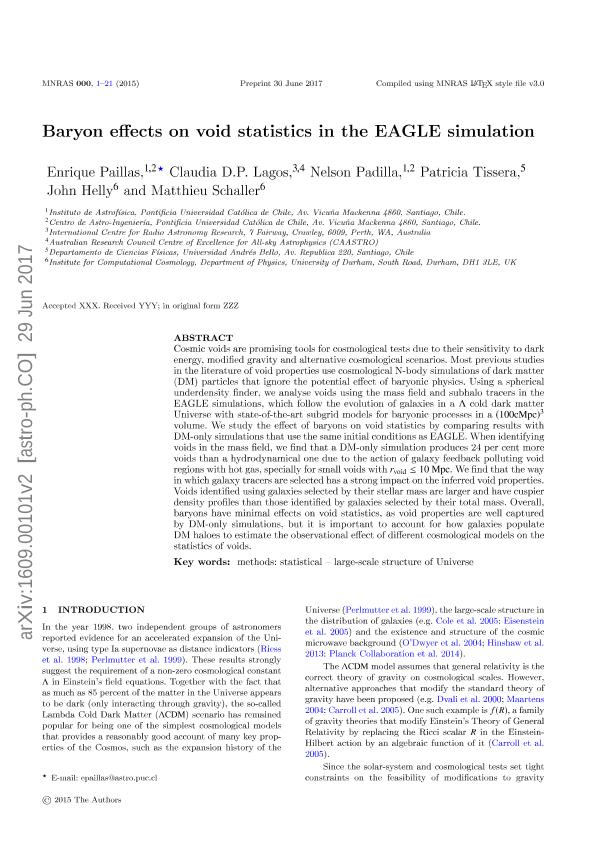Mostrar el registro sencillo del ítem
dc.contributor.author
Paillas, Enrique
dc.contributor.author
Lagos, Claudia D. P.
dc.contributor.author
Padilla, Nelson
dc.contributor.author
Tissera, Patricia Beatriz

dc.contributor.author
Helly, John
dc.contributor.author
Schaller, Matthieu
dc.date.available
2017-09-13T19:44:11Z
dc.date.issued
2017-10
dc.identifier.citation
Paillas, Enrique; Lagos, Claudia D. P.; Padilla, Nelson; Tissera, Patricia Beatriz; Helly, John; et al.; Baryon effects on void statistics in the EAGLE simulation; Oxford University Press; Monthly Notices of the Royal Astronomical Society; 470; 4; 10-2017; 4434-4452
dc.identifier.issn
0035-8711
dc.identifier.uri
http://hdl.handle.net/11336/24182
dc.description.abstract
Cosmic voids are promising tools for cosmological tests due to their sensitivity to dark energy, modified gravity and alternative cosmological scenarios. Most previous studies in the literature of void properties use cosmological N-body simulations of dark matter (DM) particles that ignore the potential effect of baryonic physics. Using a spherical underdensity finder, we analyse voids using the mass field and subhalo tracers in the Evolution and Assembly of Galaxies and their Environment (EAGLE) simulations, which follow the evolution of galaxies in a Λ cold dark matter universe with state-of-the-art subgrid models for baryonic processes in a (100 cMpc)3 volume. We study the effect of baryons on void statistics by comparing results with DM-only simulations that use the same initial conditions as EAGLE. When identifying voids in the mass field, we find that a DM-only simulation produces 24 per cent more voids than a hydrodynamical one due to the action of galaxy feedback polluting void regions with hot gas, specially for small voids with rvoid ≤ 10 Mpc. We find that the way in which galaxy tracers are selected has a strong impact on the inferred void properties. Voids identified using galaxies selected by their stellar mass are larger and have cuspier density profiles than those identified by galaxies selected by their total mass. Overall, baryons have minimal effects on void statistics, as void properties are well captured by DM-only simulations, but it is important to account for how galaxies populate DM haloes to estimate the observational effect of different cosmological models on the statistics of voids.
dc.format
application/pdf
dc.language.iso
eng
dc.publisher
Oxford University Press

dc.rights
info:eu-repo/semantics/openAccess
dc.rights.uri
https://creativecommons.org/licenses/by-nc-sa/2.5/ar/
dc.subject
Cosmology
dc.subject
Galaxy Formation
dc.subject.classification
Astronomía

dc.subject.classification
Ciencias Físicas

dc.subject.classification
CIENCIAS NATURALES Y EXACTAS

dc.title
Baryon effects on void statistics in the EAGLE simulation
dc.type
info:eu-repo/semantics/article
dc.type
info:ar-repo/semantics/artículo
dc.type
info:eu-repo/semantics/publishedVersion
dc.date.updated
2017-09-11T21:05:26Z
dc.journal.volume
470
dc.journal.number
4
dc.journal.pagination
4434-4452
dc.journal.pais
Reino Unido

dc.journal.ciudad
Londres
dc.description.fil
Fil: Paillas, Enrique. Pontificia Universidad Católica de Chile; Chile
dc.description.fil
Fil: Lagos, Claudia D. P.. International Centre For Radio Astronomy Research; Australia
dc.description.fil
Fil: Padilla, Nelson. Pontificia Universidad Católica de Chile; Chile
dc.description.fil
Fil: Tissera, Patricia Beatriz. Universidad Andres Bello; Chile. Consejo Nacional de Investigaciónes Científicas y Técnicas. Oficina de Coordinación Administrativa Ciudad Universitaria. Instituto de Astronomía y Física del Espacio. - Universidad de Buenos Aires. Facultad de Ciencias Exactas y Naturales. Instituto de Astronomía y Física del Espacio; Argentina
dc.description.fil
Fil: Helly, John. University Of Durham; Reino Unido
dc.description.fil
Fil: Schaller, Matthieu. University Of Durham; Reino Unido
dc.journal.title
Monthly Notices of the Royal Astronomical Society

dc.relation.alternativeid
info:eu-repo/semantics/altIdentifier/doi/http://dx.doi.org/10.1093/mnras/stx1514
dc.relation.alternativeid
info:eu-repo/semantics/altIdentifier/url/https://academic.oup.com/mnras/article-abstract/470/4/4434/3869633/Baryon-effects-on-void-statistics-in-the-EAGLE?redirectedFrom=fulltext
dc.relation.alternativeid
info:eu-repo/semantics/altIdentifier/url/https://arxiv.org/abs/1609.00101
Archivos asociados
